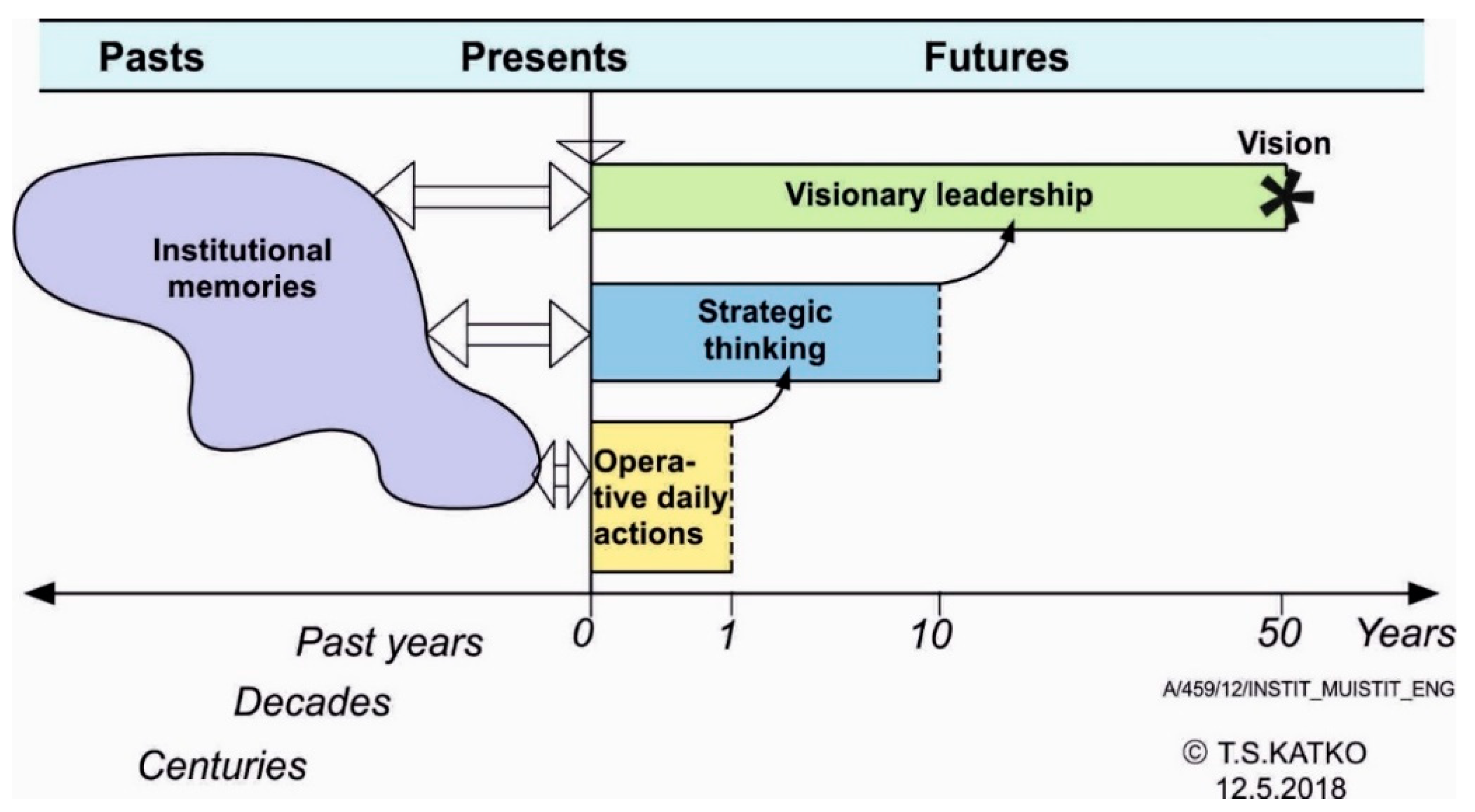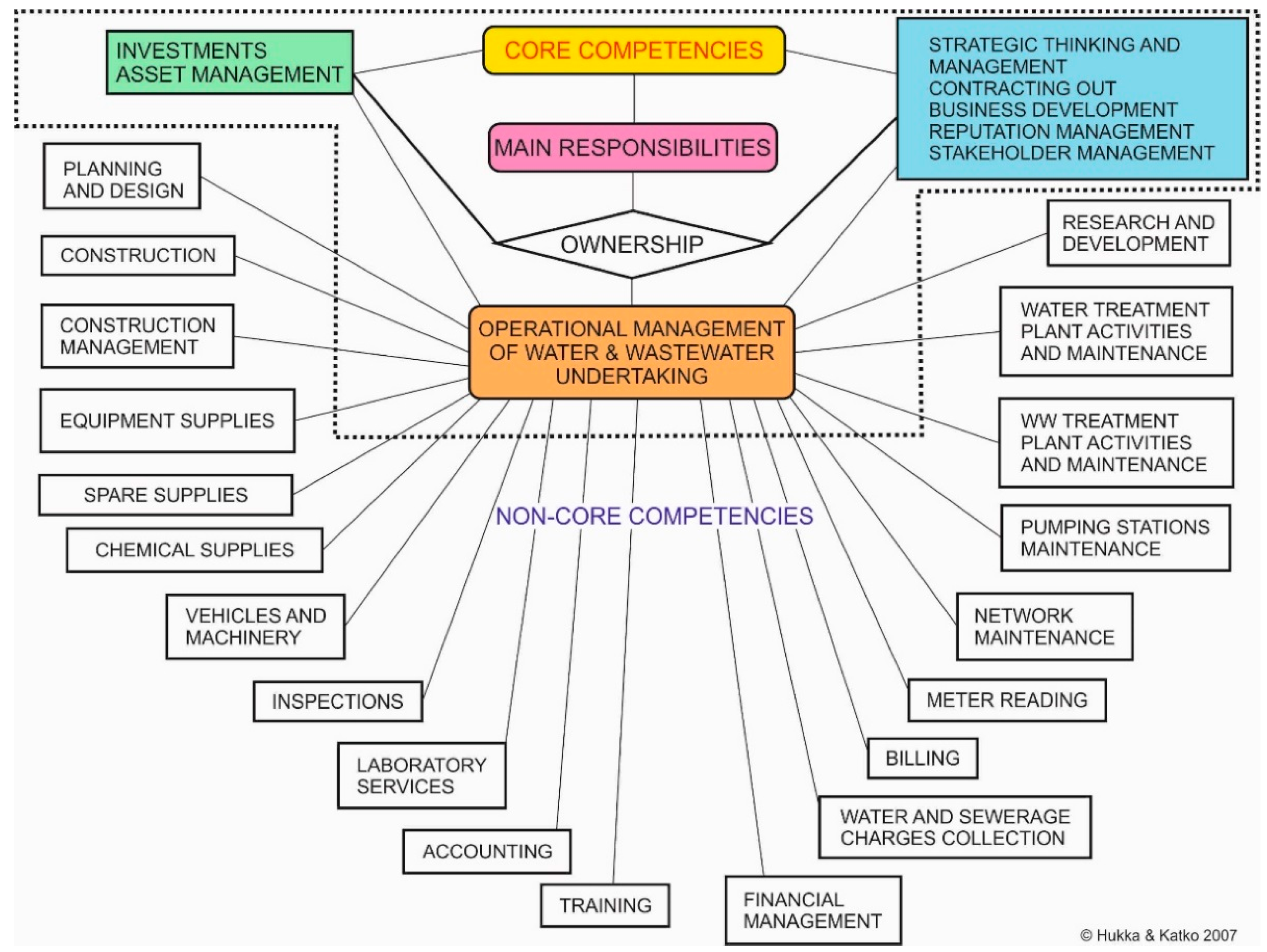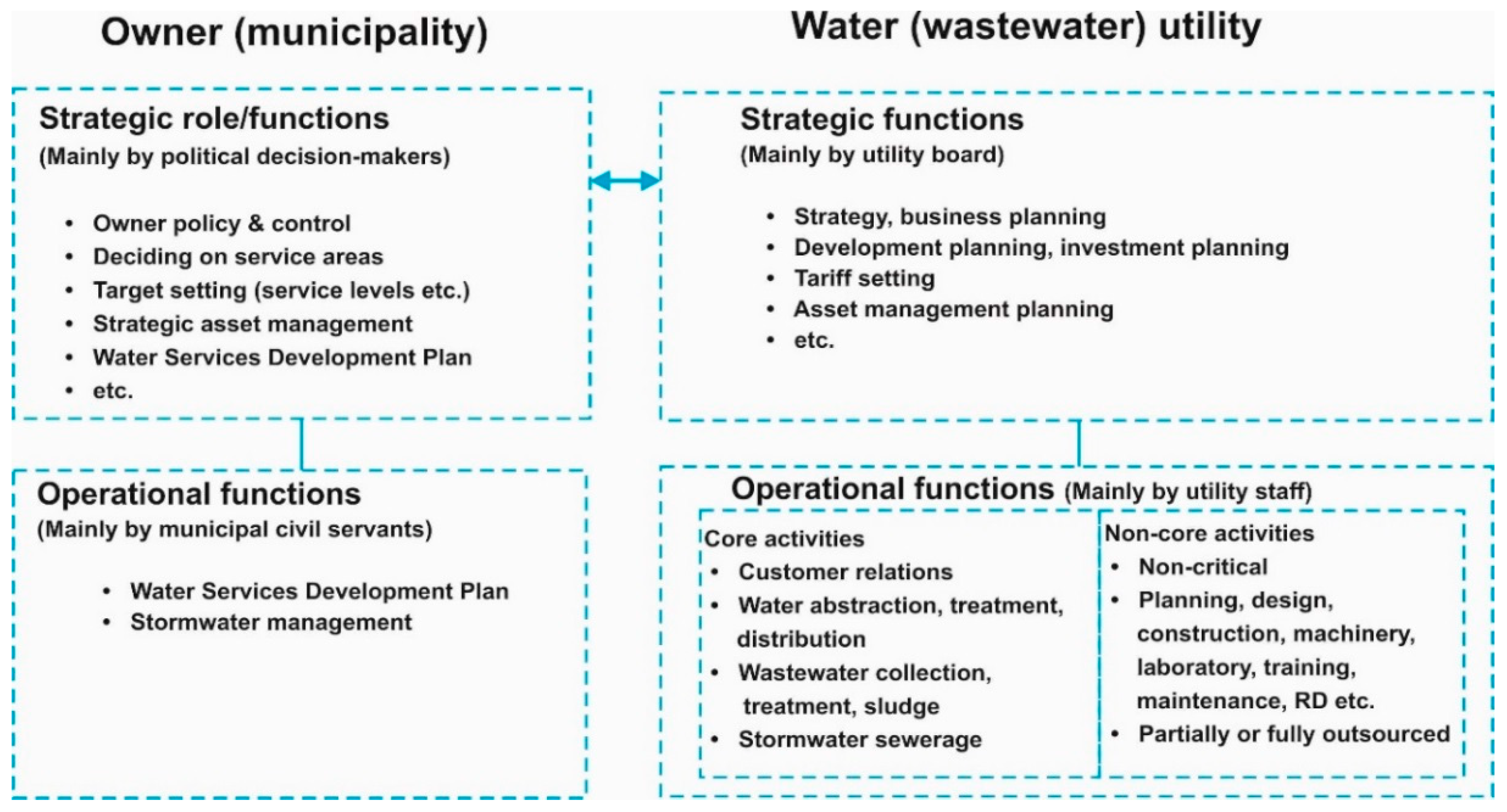1. Introduction
Water—and water services to people—is of fundamental importance to human life and the everyday function of communities. The invaluable role of water services is, yet, surprisingly poorly recognized, mainly since they are commonly taken for granted. Only if water services fail, do they get recognized by lay people including citizens, policy-makers and decision-makers. As evidence of this, an international “best in medical breakthrough” poll conducted in 2007 by the
British Medical Journal revealed that public sanitation—clean water and treated sewage—was ranked at the top out of 15 key medical advances. Approximately 11,000 people voted in the poll. Yet, the doctors who voted chose anesthesia as the number one breakthrough [
1].
Clean water is one of the major futures challenges facing mankind as noted by the Millennium Project [
2]. Futures is here used in plural form on purpose since there are several alternative futures commonly used in futures research. The recent study by UNICEF and WHO [
3] shows that currently, as many as 2.1 billion people lack access to safe drinking water globally, 4.5 billion are without safe sanitation facilities, and 0.9 billion practice open defecation.
The development of water services, both in urban and rural areas, has always required political will [
4]. As time goes by, the requirements for and expectations of better services among citizens tend to rise. Recently, the autonomy of municipal utilities has increased, expanding the responsibility of decision-makers and forcing them to familiarize themselves with the key principles and to take into account the owner’s role and policy.
A major challenge is to make the largely invisible water services more visible to decision-makers and citizens. In a historical context, water services are not only necessary but invaluable, and water services are a key component of national security of supply. Historical [
5] and more recent world-wide experiences [
6,
7,
8,
9] show how municipalities should not sell their water utilities to private corporations that seek to maximize profit in providing essential water services.
Instead, decision-makers and utilities should consider the extent to which it is feasible to outsource non-core activities to private entities, and to what extent the utility should maintain its own competence for such activities. In fact, this is what public water utilities have done since their establishment in construction, planning and designing [
10] (p. 71), maintaining the option for competition without tying their hands with excessively long contracts.
A survey from 2009 [
11], based on the views of 48 experts, showed that aging infrastructure is the biggest challenge for urban and rural water services in the coming 20 to 30 years in Finland. This is confirmed by a subsequent recent study [
12] (p. 251). Other studies from North America and Europe indicate the same, as shown later.
This paper aims at revealing the “big issues” behind aging infrastructure and finding alternative strategies and means for resolving them. The authors argue that the problems are largely related to management, institutions, organizations, and policies. This paper is based on several studies on water services development, especially in Finland, but with international examples [
13]. The paper also uses the experiences from the continuing education program “Water Services Leadership and Development (WASLED)” conducted in 2009–2016, with 74 participants mainly from Finnish water utilities. The latest findings are from a study with interviews of a dozen water utility managers [
12]. In many ways, the requirement to see water services in a wider institutional framework is analogical and linked to the need for Integrated Urban Water Management (IUWM). As Srinivas [
14] points out, the idea of IUWM is to address the entire urban water system as part of a coherent framework that is nested within the well-known notion of Integrated Water Resources Management (IWRM) which can, however, be interpreted in many ways [
15].
This paper first explores the timeframe of water services management, followed by frameworks on core and non-core operations of water utilities in relation to the roles of municipal decision-makers and civil servants as well as those by the utility board and utility staff. In the following text, we review the relevant body of literature, discuss our findings and provide conclusions drawn from our efforts.
2. Long Timeframe of Water Services Development
Many sectors nowadays use futures and strategic thinking for identifying and having influence on the development of their sector and services. The practice of “prediction” by futurologists has been replaced by futures research and forecasting that both try to have an active influence on preferable futures and required development paths [
16].
Futures can be explored through three different timeframes (
Figure 1): Operative daily actions (one year); strategic thinking (5–10 years), and visionary leadership (10–50 years). The core of visionary thinking is that a sector or organization should explore a state of futures which seems most preferable.
From the identified visionary state of preferable future, alternative development paths and strategies are to be explored for reaching the identified state. Due to path dependence, major strategic decisions may even have an impact lasting over a century—to the futures and to the pasts [
17]. Thus, the quartal of water service should be calculated out of a millennium, i.e., some 250 years. Sometimes the argument “we are not interested in history, we are interested in the futures” is presented seriously. History and futures are, however, not alternatives but they are strongly interconnected. This is mainly due to the path dependence of water services infrastructure development [
4], whereby certain strategic decisions have unavoidable long-term impacts.
Another important point is to understand the special features of water services and systems. As Pietilä et al. [
18] point out water services and infrastructure have many unique and specific features that need to be understood when exploring the ways of their governance and management. Water is a basic need and a necessity for all, while the costs of supplying water services have to be covered. There is most likely no simple answer to the problem of inadequate water services. The special circumstances of each country, region and location have to be taken into account. It is relatively easy to understand such differences in natural conditions, but perhaps more difficult to take into account social, cultural, religious, legislative, administrative, and legal traditions. These dimensions together with informal rules are often of vital importance for any societal action.
A recent “isomorphic” idea [
19] applied in water services is to assume that by increasing the size of the system (from catchment collection to disposal of treated wastewater) we will automatically receive benefits and economic savings. However, findings show that the potential benefits will not automatically bring advantages or savings. Once the systems are expanded, additional transaction costs will easily be created. On the other hand, bigger size will make it possible to hire more specialized experts and thereby develop operations.
In its water resources strategy for 2011–2020, the Ministry of Agriculture and Forestry of Finland [
20] defined its mission as being to “secure sustainable use of water resources as well as prepare for risks concerning security, health and environment and by this way create conditions for well-being and multifaceted economic activities.” The Ministry specifically argues that by combining networks and merging of organizations into bigger units, operational security in response to disturbances can be improved. This may well be true in some cases, but its validity as a “panacea” can be questioned seriously. In this document, water services are seen as a subsidiary to water resources management, the justification of which can also be questioned. According to current legislation, they are rather to be seen as parallel.
3. Aging Infrastructure and Need for Rehabilitation as the Biggest Challenge
The challenge of aging infrastructure is a key challenge worldwide as shown by the assessments on the state of infrastructure made in Finland [
21], Canada [
22], Norway [
23], UK [
24], USA [
25], Africa [
26] and Kenya [
27]. The estimated condition and funding gaps in water and wastewater infrastructure in four OECD (Organisation for Economic Co-operation and Development) countries were explored (
Table 1). These funding gap estimates do not include the respective rehabilitation, renewal and replacement financing requirements of stormwater infrastructure and house connections, both of which are also considerable. Although the data and the scales used are not directly comparable, they still show the severity of the problem.
4. Frameworks for Core and Non-Core Operations
In many business fields, it is more than common for companies to explore their core-competencies and non-core competencies. These can also be called operations or activities (
Figure 2). The idea is to determine the extent to which water utilities could and should outsource their non-core competencies to the private sector or other external bodies. Particularly, they should think of retaining the know-how that enables them to engage suppliers in a reasonably competitive tendering process as well as strategic planning and management.
Worldwide municipalities or other respective public institutions have a fundamental role in water services as the owner of utilities. Municipalities or other public bodies own some 90% of the world’s urban water utilities, 95% of wastewater and arguably 100% of stormwater systems. Therefore, it is important to explore the roles of municipalities and other related bodies regarding water services.
Figure 3 elaborates the key strategic functions of the municipality and the water and wastewater utility and their board (mostly integrated) in the Finnish case. The municipality’s strategic functions, performed mainly by municipal decision-makers, include especially: Owner policy and control; deciding on service areas; target setting; strategic asset management, and water services development planning. The strategic functions of the utility board typically consist of: The planning to carry out its strategy; business operations; development and investment planning; asset management, etc. The operational functions of the municipality, carried out mainly by municipal civil servants, can include tariff decisions, water services development, and decisions on service areas. These functions may also be partly strategic by nature. Yet, both political decision-makers and municipal civil servants may play a role in all three areas.
The operational functions of a water utility, mainly carried out by its personnel, consist of core and non-core operations. Core operations are those performed by the utility whereas non-core operations can be, at least partly, outsourced. In different countries, these roles and functions may vary, but it is important to recognize the basic roles of the key parties.
5. Discussion
The findings above raise the question: What kind of actions and strategies are needed and could be used for tackling the challenge of aging water services infrastructure and systems. The need for such strategies and rethinking is urgent. However, it is obvious that these objectives cannot be met by any single action, and, therefore, we should consider alternative ways in a wider framework.
One such framework is to think about this in the Political, Economic, Social, Technological, Ecological, and Legislative (PESTEL) framework commonly used in Futures Research and Administrative Studies. This framework will force us to explore the issues in a wider framework. Such analysis is suggested for further studies, perhaps added by the dimension of ethics, thus expanding to the PESTELE framework and broadening its applicability.
Professional will refer to the willingness and competence of professionals to act and reason in favor of such strategies and long-term plans that will be needed for resilience (the ability of the water service to absorb disturbance) and sustainable water services. These may include long-term investment plans, appropriate pricing and tariff structures, etc. Paradoxically, in the Finnish case bigger utilities are yielding a more than reasonable rate of return to the owners (cities) while at the same time, it is argued that there are not enough funds for rehabilitation.
A big challenge is to raise awareness and make the current aging infrastructure systems more visible to policy-makers, decision-makers and citizens. Relatively speaking this is as big a challenge as proper water pollution control that in cities and many industries in the western world have largely been solved. However, that challenge was visible when surface waters were polluted. In the case of aging infrastructure and networks, in particular, the challenge is much more demanding due to its invisible nature. The timeframe of local government decisions is just four years for elected persons versus the need for thinking several decades ahead; it is within a strategic or visionary timeframe.
One suggested way is to revisit our current educational programs that in water supply and sanitation as well as in environmental engineering seem to focus on non-core activities in terms of water utilities. The elements of core activities should be introduced and enforced in the syllabi. This need seems to be valid in any part of the world as is the challenge of aging infrastructure. Besides, our studies show that after some three to five years, water engineers will shift from “classical“ engineering duties more towards management, institutional and even policy issues.
A survey made in 2007 (cited by [
13] (p. 186)) showed that without extra incentives there will be a lack of water services experts in Finland in the future. It also pointed out that the identified challenges are mainly institutional by nature; governance, organizational, economic, management, and legislative issues. This should make the sector reconsider to what extent such changes should be taken into account in current educational programs, where institutional and management skills are largely ignored.
We should not only focus on data collection, modelling and technical artefacts, but we should also think and act in strategic ways to have better institutions (formal and informal rules of the game as defined by New Institutional Economics) for viable futures [
31]. Fundamentally, we have to have better “rules of the game” and more resources allocated to Research, Development and Institutional Innovations (RDII) activities in the future.
It is obvious that both political and professional will is needed to tackle the challenge of aging infrastructure. The idea that professionals should not touch policy issues is irresponsible since otherwise, no-one will produce the needed know-how and knowledge as the basis for decision-making. On the whole, we will need to understand better institutions—formal and informal rules of the game—for viable futures.
6. Conclusions
This review paper leads us to several key conclusions. First, we need to consider worldwide strategies and actions for resolving the challenge of aging water services infrastructure and systems. In addition to political will, professional will—the willingness and competence of professionals to act and reason in favor of appropriate strategies, long-term plans and actions—is needed for developing and ensuring resilient and sustainable water services. This requires raising awareness and making the aging infrastructure systems more visible to policy-makers, decision-makers and citizens. Our educational programs in water supply and sanitation as well as in environmental engineering should include more management, institutional, policy and governance issues that are core competencies in the water services sector as a whole. Furthermore, more resources need to be allocated to Research, Development and Institutional Innovations activities in the future.
In the form of a poem we can conclude: “
Aging infrastructure is a headache everywhere, so it’s high time to renovate and lessons share; to make the hidden systems visible, that for us all are indispensable” [
13] (p. 267).








